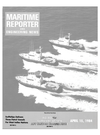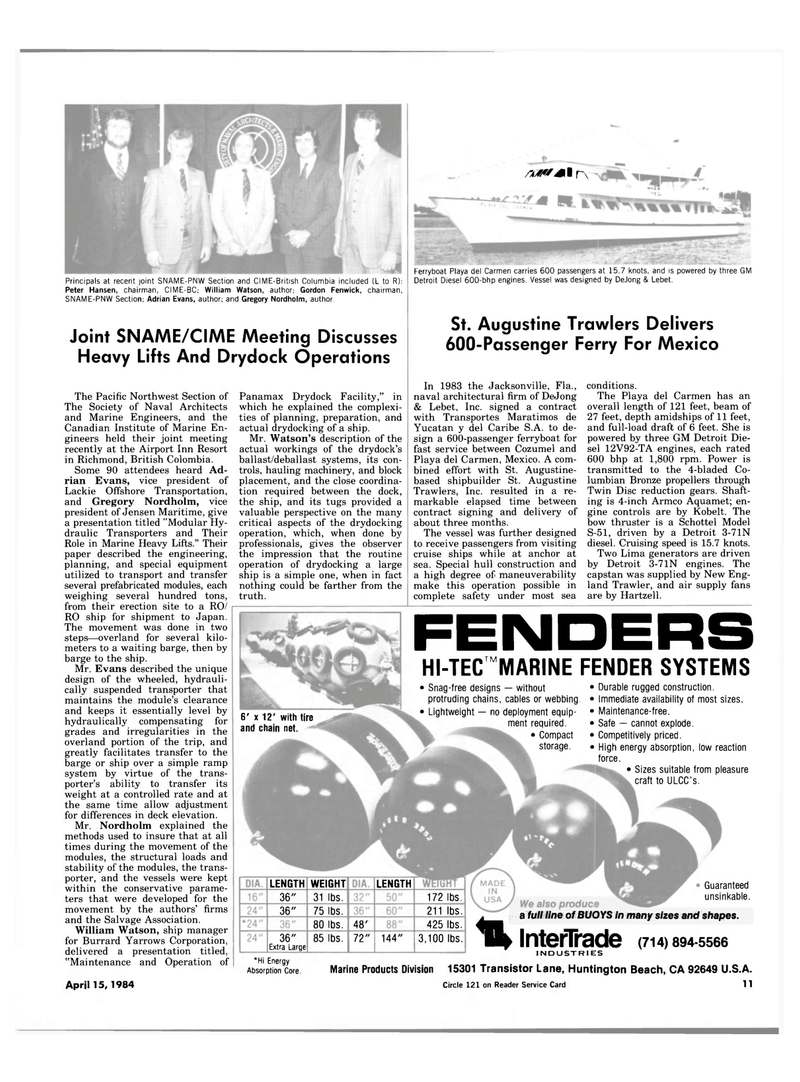
Page 9: of Maritime Reporter Magazine (April 15, 1984)
Read this page in Pdf, Flash or Html5 edition of April 15, 1984 Maritime Reporter Magazine
Principals at recent joint SNAME-PNW Section and CIME-British Columbia included (L to R):
Peter Hansen, chairman, CIME-BC; William Watson, author; Gordon Fenwick, chairman,
SNAME-PNW Section; Adrian Evans, author; and Gregory Nordholm, author
Joint SNAME/CIME Meeting Discusses
Heavy Lifts And Drydock Operations
The Pacific Northwest Section of
The Society of Naval Architects and Marine Engineers, and the
Canadian Institute of Marine En- gineers held their joint meeting recently at the Airport Inn Resort in Richmond, British Colombia.
Some 90 attendees heard Ad- rian Evans, vice president of
Lackie Offshore Transportation, and Gregory Nordholm, vice president of Jensen Maritime, give a presentation titled "Modular Hy- draulic Transporters and Their
Role in Marine Heavy Lifts." Their paper described the engineering, planning, and special equipment utilized to transport and transfer several prefabricated modules, each weighing several hundred tons, from their erection site to a RO/
RO ship for shipment to Japan.
The movement was done in two steps—overland for several kilo- meters to a waiting barge, then by barge to the ship.
Mr. Evans described the unique design of the wheeled, hydrauli- cally suspended transporter that maintains the module's clearance and keeps it essentially level by hydraulically compensating for grades and irregularities in the overland portion of the trip, and greatly facilitates transfer to the barge or ship over a simple ramp system by virtue of the trans- porter's ability to transfer its weight at a controlled rate and at the same time allow adjustment for differences in deck elevation.
Mr. Nordholm explained the methods used to insure that at all times during the movement of the modules, the structural loads and stability of the modules, the trans- porter, and the vessels were kept within the conservative parame- ters that were developed for the movement by the authors' firms and the Salvage Association.
William Watson, ship manager for Burrard Yarrows Corporation, delivered a presentation titled, "Maintenance and Operation of
Panamax Drydock Facility," in which he explained the complexi- ties of planning, preparation, and actual drydocking of a ship.
Mr. Watson's description of the actual workings of the drydock's ballast/deballast systems, its con- trols, hauling machinery, and block placement, and the close coordina- tion required between the dock, the ship, and its tugs provided a valuable perspective on the many critical aspects of the drydocking operation, which, when done by professionals, gives the observer the impression that the routine operation of drydocking a large ship is a simple one, when in fact nothing could be farther from the truth. /urn? a I rv
Ferryboat Playa del Carmen carries 600 passengers at 15.7 knots, and is powered by three GM
Detroit Diesel 600-bhp engines. Vessel was designed by DeJong & Lebet.
St. Augustine Trawlers Delivers 600-Passenger Ferry For Mexico
In 1983 the Jacksonville, Fla., naval architectural firm of DeJong & Lebet, Inc. signed a contract with Transportes Maratimos de
Yucatan y del Caribe S.A. to de- sign a 600-passenger ferryboat for fast service between Cozumel and
Playa del Carmen, Mexico. A com- bined effort with St. Augustine- based shipbuilder St. Augustine
Trawlers, Inc. resulted in a re- markable elapsed time between contract signing and delivery of about three months.
The vessel was further designed to receive passengers from visiting cruise ships while at anchor at sea. Special hull construction and a high degree of maneuverability make this operation possible in complete safety under most sea conditions.
The Playa del Carmen has an overall length of 121 feet, beam of 27 feet, depth amidships of 11 feet, and full-load draft of 6 feet. She is powered by three GM Detroit Die- sel 12V92-TA engines, each rated 600 bhp at 1,800 rpm. Power is transmitted to the 4-bladed Co- lumbian Bronze propellers through
Twin Disc reduction gears. Shaft- ing is 4-inch Armco Aquamet; en- gine controls are by Kobelt. The bow thruster is a Schottel Model
S-51, driven by a Detroit 3-7IN diesel. Cruising speed is 15.7 knots.
Two Lima generators are driven by Detroit 3-71N engines. The capstan was supplied by New Eng- land Trawler, and air supply fans are by Hartzell.
April 15, 1984
FENDERS
HI-TEC "MARINE FENDER SYSTEMS
LENGTH 36" 36" 36"
Extra Large
WEIGHT 31 lbs. 75 lbs.
LENGTH 172 lbs. 211 lbs. 80 lbs. 48' 425 lbs.
Guaranteed unsinkable. a full line of BUOYS in many sizes and shapes. 85 lbs. 72" 144" 3,100 lbs. ^ « »M'I iiiic vi uuv vir :
H InterTrade *Hi Energy
Absorption Core.
INDUSTRIES (714) 894-5566
Marine Products Division 15301 Transistor Lane, Huntington Beach, CA 92649 U.S.A.
Circle 121 on Reader Service Card 1 1 6' x 12' with tire and chain net. • Snag-free designs — without protruding chains, cables or webbing • Lightweight — no deployment equip- ment required. • Compact storage. • Durable rugged construction. • Immediate availability of most sizes. • Maintenance-free. • Safe — cannot explode. • Competitively priced. • High energy absorption, low reaction force. • Sizes suitable from pleasure craft to ULCC's.

 8
8

 10
10
